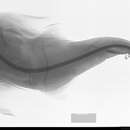Diagnostic Description
provided by Fishbase
Diagnosis: Mid-dorsal line lacking thorns or enlarged, sharp, pointed dermal denticles; eye-spiracle distance larger than 1.5 times eye diameter in specimens larger than 60 cm TL; each nasal flap with 2 rod-like barbels, outer barbel divided; coloration grayish to brownish yellow, male dark-spotted, females with abundant whitish spots (Ref. 110242).Description: Dorsal surface covered with interspersed denticles of relative roughness, a densely concentrated patch of small curved spines along anterior pectoral-fin margins in mature males, poorly developed in females; ventral surface comparatively smooth, except for narrow bands of denticles along anterior margins of both pectoral and pelvic fins; head rounded, length around 5 times in TL, with a maximum width occurring anterior of gill openings; moderate tubercles interspersed above mouth and eye crests, smooth oval patch above midpoint of mouth in between eyes; eyes almond-shaped, closely set, with an interorbital space 11-13 times in TL; eye-spiracle distance relatively large, 30â43 times in TL; spiracles crescent-shaped with pronounced interior papillae along posterior margin; interorbital space around 1.1 times larger than interspiracle space; center of upper lip arch exposed at midpoint of upper jaw, exposure semi-oval in shape; labial furrows, roughly equal in length, extending from corners of mouth medially, with upper labial furrow partially covered with dermal folds; distinct nasal flaps protruding from dermal folds above mouth, 2 barbels protruding from each flap; inner nasal barbels rod-like, containing little if any fringe; outer nasal barbels rod-like with a small branch protruding ventrally near tip; nostrils large, protruding slightly, and tear-shaped; dermal folds along exterior of head, 1 small lobe present at corners of mouth extending ventrally; mouth length about 0.3 times as long as mouth width; dentition consisting of small, dagger-like teeth, conical without cusplets on a broad base, in 2 orderly longitudinal rows on upper jaw, 3 rows on bottom jaw, no teeth at symphysis, 10 teeth by row in each jaw; pectoral fins large and broadly rounded, originating just behind gills; anterior margin of pectoral fin mostly straight, 0.8â0.9 as long as pectoral length, extending to a lateral apex; margin from lateral apex to posterior-most lobe slightly concave; posterior lobe broadly rounded; pectoral inner margin about 1/2 of pectoral length, convex, and with a small lobe near pectoral base; overall pelvic fin shape somewhat triangular with rounded fin tips; pelvic fins originating anterior to pectoral fin free rear tips; pelvic fin length 0.5-0.8 long as pectoral fin length; pelvic-fin base usually longer than pectoral-fin base, anterior margin 0.5â0.65 times as long as pelvic fin length; posterior margin of pelvic fin straight to posterior free tip approximately 0.7 times fin length; pelvic inner margin straight and short, approximately 0.4 times as long as pectoral fin length; pelvic-fin insertion furrows on ventral side extend in a narrow ellipse to anterior apogee of vent, vent is within ellipse; 1 pelvic-fin tip extends to 1st dorsal origin, the other does not; dorsal fins slightly angular, 2nd dorsal fin slightly smaller than 1st dorsal fin, with denticles covering the entirety of both fins; dorsal-caudal space 1.0â1.4 times longer than interdorsal space; anterior margin of both dorsal fins straight, nearly equidistant; dorsal-fin bases subequal; posterior margins straight, about 0.5â0.7 times as long as anterior margins; inner margin of dorsal fins straight, approximately 0.2â0.5 times as long as anterior margins; caudal peduncle compressed dorso-ventrally with lateral longitudinal ridges, tapering posteriorly; caudal fin lobelike, markedly at dorsal apex, dorsal margin broadly rounded, about 0.7â0.9 times as long as preventral caudalfin margin; subterminal caudal-fin margin approximately 1.4 times longer than caudal upper postventral margin; caudal lower postventral margin slightly convex, approximately 1.5 times longer than caudal upper postventral margin (Ref. 110242).Coloration: Grayish to brownish yellow; male with dark spots, subequal to smaller than eye diameter; females with abundant whitish spots, smaller than eye diameter (Ref. 110242).
Morphology
provided by Fishbase
Dorsal spines (total): 0; Dorsal soft rays (total): 0; Analspines: 0
Biology
provided by Fishbase
Currently known from depths between 100-151m (Ref. 110242).
David's angelshark: Brief Summary
provided by wikipedia EN
David's angelshark (Squatina david) is a species of angelshark newly described in 2016. It can grow up to around 75 cm in length and is coloured greyish to brownish yellow. Male specimen are dark spotted, while females have abundant whitish spots. David's angelshark inhabits the northern coast of South America from Colombia to Suriname and is currently known from a depth between 100 and 150 m.
It is a sister species of the angular angel shark (Squatina guggenheim) and the hidden angelshark (Squatina occulta).
- license
- cc-by-sa-3.0
- copyright
- Wikipedia authors and editors

